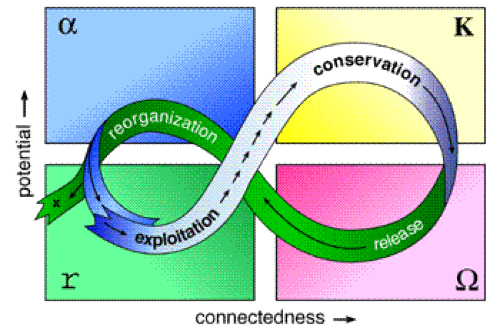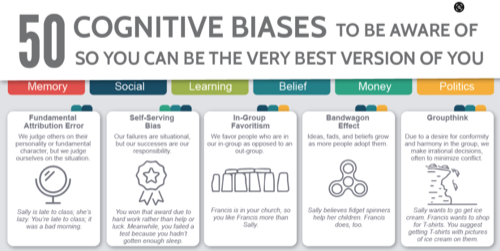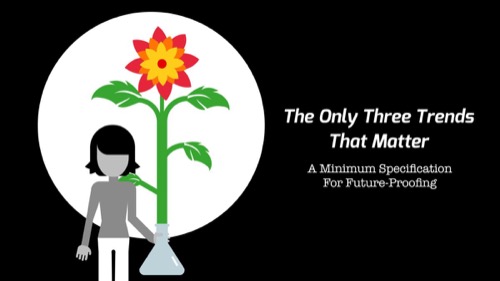Leah Zaidi, Futurist

Cool Tools Show 300: Leah Zaidi
Our guest this week is Leah Zaidi. Leah is an award-winning futurist and Research Director at the Institute for the Future. She helps companies and countries design their future. You can find Leah on Twitter @leah_zaidi and at leahzaidi.com.
Subscribe to the Cool Tools Show on iTunes | RSS | Transcript | See all the Cool Tools Show posts on a single page
Show notes:

Panarchy aka the Adaptive Cycle: it’s an ecological model that describes basic ecosystem dynamics and what we’re experiencing with Covid.
Panarchy is one of my favorite tools. It happens to be the one tool that I think best describes what we’re experiencing with COVID. So the Panarchy, also known as the Adaptive Cycle, is an ecological model and it basically explains ecosystem dynamics at their most fundamental level. What it says is that we go through four stages and they all kind of cycle into each other. So the first phase is Exploitation, where there’s rapid expansion. So if you think of this as like a forest, new species come in, they kind of spread out and everything grows very quickly. Then we go into a Conservation stage, which is slow build up, slow accumulation, but everything is kind of matured. And then we might go into a Release stage. This is where things get interesting. This is when an event can happen that can throw everything off, that can burn down the systems. So if you think about like a forest fire, literally burning down a forest, it creates the conditions for new things to arise out of that, which is then a Reorganization phase.So what we’re still kind of going through is a Release period. We had early stages of growth throughout many of our systems. Then they reached a point of maturity and then a revolt happened. Something came in that was fast moving, fast acting, like the virus. Created the conditions for release, and now we might see new things emerge out of that. Not necessarily good things, but new things. There’s a really great video on YouTube by Noah Raford, who’s describing what the automotive industry went through in terms of its initial conception to the reorganization that it’s experienced with electric vehicles.

50 Cognitive Biases from Visual Capitalist: common errors in our thought processes that we should all be aware of.
I love infographics and visual tools that help us grasp some of the more complicated issues that we’re dealing with or reveal something to us about ourselves. So this is a great one from Visual Capitalist, which has tons and tons of great frameworks and models on there, but it describes the 50 common biases that we tend to fall into in the modern world. They can be things like the placebo effect, which is taking something that’s a fake or a substitute and not really meant to cure the thing that you’re doing, but really has the same effect somehow. Or the Ikea effect, which is when we build something for ourselves, we place greater value onto it. And so just being aware of some of the biases that we ourselves might be committing when we work on things, when we work with other people. It’s just great to keep in mind.

The Only Three Trends That Matter: A Minimum Specification for Future-Proofing — My model for the absolute minimum you should think about when doing any strategy, innovation policy, etc. work.
I developed this about four years ago and then I went through the excruciating process of peer review to get it out into the public. This tool is basically work that came out when I was looking at many, many reports on the future of work. I went through about 30 to 40 reports on the future of work. And all of them talked about AI and automation, not a single one of them talked about the implications of climate change on the future of work. I just kept asking myself, “What planet is the future of work happening on?” Because I don’t think it’s happening on earth if this is the conclusions that we’ve come to. So what I essentially did is I took apart those reports and then I looked at other areas and I thought when we do things like trend reports or put them out and we talk about the future and we talk about where things might go, there’s just a lot of noise, right? So we think that anything is important and everything is important, but when you consider what is absolutely critical, what’s the bare minimum? Like what do we have to consider no matter what work we’re doing, whether we’re inventing a product or creating a policy or thinking better systems and the way they might evolve, what’s the absolute minimum? And I came up with three things. 1. We have to think about environmental sustainability. 2. We need to consider equality, justice and democracy. 3. We need to think about AI and algorithms, specifically looking at the underlying ethics and biases of these things. If we do that bare minimum, regardless of the industry or the type of work that we’re doing, then at least we’ve got some bases covered for where the future might go and the important things to think about.

Beckhard-Harris Change Formula (D x V x F > R): Suggests that change happens when dissatisfaction with the status quo, a vision for the future, and actionable first steps outweigh resistance to change.
This is a fun one. It also applies to organizations, but it can apply to the bigger systems issues as well. So the Beckhard-Harris Change equation basically says that in order for change to happen, three things have to take place: 1. You have to be dissatisfied with the current state. So if you’re happy with the way they are, change is probably not going to happen. 2. You need a clear vision of the future. So what it is that you want, the outcome that you’re aiming for. 3. You need a set of first steps. They don’t have to be perfect. They don’t have include every step along the way to your vision, but just an articulated set of first steps that you’re going to take to achieve that vision. Then once you have those three things in place, change can take place. I wouldn’t put too much emphasis on the formula itself. It’s kind of more like all three things have to be in place. So it’s not necessarily that you can have less of a vision and have more unhappiness and that’s going to be the thing that creates change. It’s more so like you need a baseline of all three of those things in order for change to happen. It’s really hard to quantify, like how much dissatisfaction, for instance, has to be in place. And who has to be dissatisfied? That can be another question. So when you start to pick it apart, you can see how a model can be useful or a tool can be useful sometimes. And then in other situations it’s completely out of place. A good example here is with politicians who can’t articulate what their plan is. Like, why should you get elected? What’s that vision that you’re articulating there? Whereas if somebody else comes in with a very clear vision, that can be quite compelling. You might be inclined to help them.






